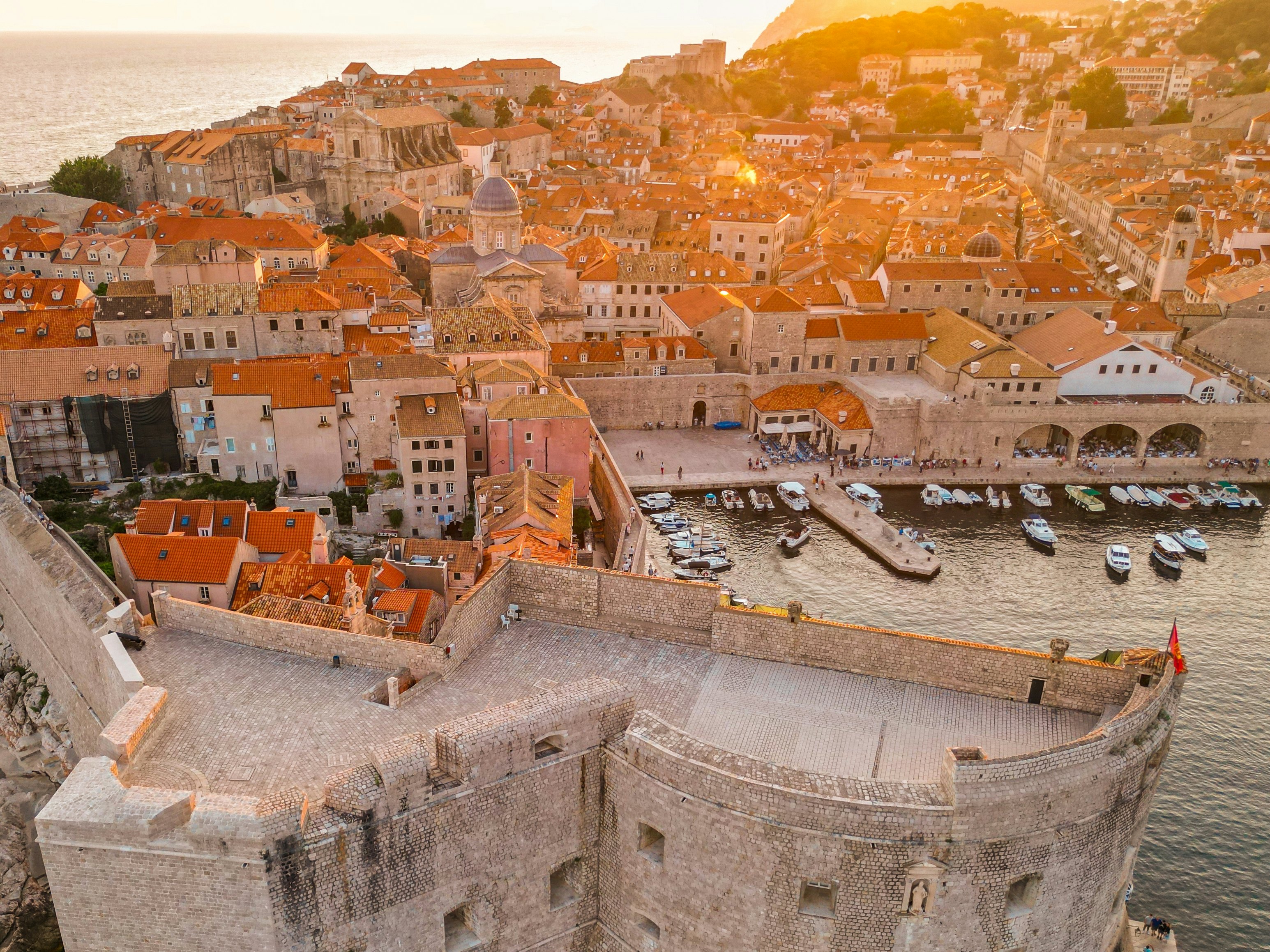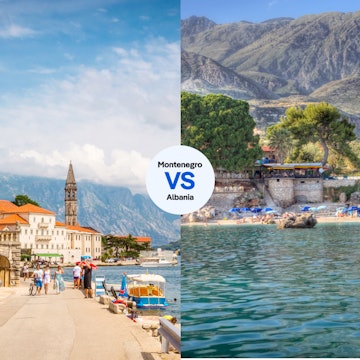

See the best of Croatia with our week-long itinerary. DaLiu/Shutterstock
For one of the most beautiful stretches of Mediterranean coastline, with glittering islands, wonderfully well-preserved medieval towns, pristine national parks and fabulous cuisine, head to Croatia.
Starting in Zagreb and ending in Dubrovnik, this seven-day itinerary is perfect for first-time visitors. You’ll explore the Croatian capital as well as UNESCO World Heritage-listed old towns on the Dalmatian coast, hopping on a catamaran or ferry between exquisite islands along the way. We’ve included some gorgeous beaches, breathtaking architecture, delicious food and wine, some outstanding museums, and sunsets to swoon over. What are you waiting for?

When to arrive: Late spring and early fall are great times to visit Croatia, thanks to pleasant temperatures and fewer crowds. However, for the smoothest connections out to the islands, you'll want to visit Croatia in the high-season months of June to August, when ferries are running the most frequent services.
How to get to/from the airports: It is a 40-minute bus ride from Zagreb's airport into the city center bus station and tickets can be bought online in advance or from the driver. Taxis are available outside the terminal. In Dubrovnik, jump on the airport shuttle bus at the main bus station, Grawe station, at the Old Town cable car stop or outside One Suite hotel. Buy tickets at the stops or online.
What to pack: Swimming shoes are highly recommended for beach visits. It is not acceptable to walk around beach towns in your swimwear, so be sure to pack non-beach clothes too. Include some smarter outfits for evenings out and clothes that will cover bare shoulders and thighs when visiting religious sites.

Day 1: start your week in Zagreb
Many Croatian itineraries just stick to the coast and islands – but in missing the Croatian capital, you’re really only seeing half the country. Zagreb has a number of excellent museums and galleries to visit, fabulous bars, cafes and restaurants, and a beautifully preserved old city center filled with Secessionist-style architecture.
How to spend the day: Start with a walking tour of the Upper Town (Gornji grad), which centers on the iconic St Mark’s Church. Don’t miss the excellent (and unique!) Museum of Broken Relationships. Then head downhill and visit the big open market and the beautiful Gothic cathedral. From bustling Ban Jelačić Square, wander through the parks and squares that run down towards the main railway station.
Take a break: When you feel like a coffee or a drink head along Tkalčićeva, a narrow, pedestrianized street teeming with vibrant cafes.

Day 2: watch the sunset from the waterfront in Zadar
Morning: Take an early bus to Zadar, around a 3.5-hour journey. If you’re driving on your own, consider stopping off at the unforgettable Plitvice Lakes National Park on the way.
How to spend the day: Zadar’s old town is a beautiful cluster of narrow streets and medieval churches, all arranged along a narrow peninsula with jaw-dropping sunsets from its waterfront. Visit the Cathedral of St Anastasia and the distinctive Church of St Donatus, beside the Roman Forum.
Take a break: Stop for an ice cream, or sit on the seafront by the remarkable Sea Organ (a quayside stone “instrument” that makes haunting noises powered by the tide), as you admire the view over to the islands.
Dinner: Before settling in for a standout dinner at Foša, which serves top-notch seafood and has a lovely waterside terrace (bookings advised), watch the sunset from the Greetings to the Sun installation on the waterfront.

Day 3: soak up the atmosphere in Split
Morning: It’s around 2.5 hours by bus to your base for the next couple of nights: Split, a coastal city with incredible architecture and popping nightlife.
How to spend the day: The lively heart of Split is Diocletian’s Palace. This UNESCO World Heritage Site was built in the 4th century as a truly magnificent retirement palace for the Roman emperor Diocletian. The complex is packed with hundreds of buildings that have been added throughout the ages and today is home to around 3000 people. Start your sightseeing here and don’t worry about getting lost – that’s half the fun.
Find your way to the center of the palace to admire the well-preserved colonnaded Roman Peristil (courtyard), and the octagonal Cathedral of St Domnius, which was originally Diocletian’s mausoleum. Below ground, the palace’s substructures are a wonderfully atmospheric place to explore. Don’t be surprised if you get the feeling dragons might be lurking: when filming Game of Thrones, these substructures stood in for the home of Daenerys’s... er... children.
Dinner: You’ll find plenty of cafes, restaurants and bars in the old city for when you start to feel peckish. Nosotromo, across from the fish market, is one of the best places to enjoy fresh Adriatic seafood. In the evening, take a stroll and grab a drink on the city’s Riva waterfront promenade.

Day 4: relax on the iconic Zlatni Rat beach near Bol
Morning: Take a fast catamaran from Split to Bol on Brač Island. This pretty little town is most famous for Zlatni Rat beach, a glorious spur of smooth white pebbles and shingle that extends 500m (1640ft) straight out into the Adriatic, reached by a mile-long stroll along a pine-shaded waterfront promenade.
How to spend the day: The beach is hugely popular, and is also a great spot for windsurfing thanks to its steady winds. For astounding views across to Hvar and beyond, take a two-hour hike up to Vidova Gora. At 778m (2552ft), this is the highest point in the Adriatic Islands. Don’t forget to take water, sunscreen and a sun hat, as there’s virtually no shade on the trail up.
In the evening: If you have time in the evening, take a local bus to see UNESCO-listed Trogir and its amazing 13th-century cathedral.
Planning tip: If you're traveling outside of high season, you won’t make it to Bol via direct catamaran as they only run from June to September. But no worries: you can take the regular ferry from Split to Supetar and then the bus across the island to Bol – just allow enough time on the way back, as the bus sometimes gets stuck in traffic waiting for the ferry outside Supetar.

Day 5: chill out in Hvar Town, and explore Korčula’s old town
Morning: In high season (June to September) you have several choices of catamaran when traveling from Split to Korčula Town, and it’s easy enough to stop off at Hvar Town for some chill-out time on the way. (Note that catamarans between Split, Hvar, Korčula and Dubrovnik in the summer do get fully booked up, so make sure you buy your tickets in advance. )
How to spend the day: The glittering capital of Hvar Island, Hvar Town is one of the most glamorous spots in Croatia, famous for a vibrant nightlife scene combined with historic architecture in a stunning setting. Wander the narrow streets of the old town past pretty churches and squares; if you fancy a swim, take a boat ride out to the Pakleni Islands. Then, take an afternoon catamaran to Korčula – or if you fall in love with Hvar and can’t bear to leave, count on taking a catamaran direct to Dubrovnik tomorrow.
Korčula Town is a picture-perfect walled settlement on a boat-shaped peninsula jutting into the Adriatic. Tightly clustered within a ring of walls and towers, the old town centers on the 15th-century St Mark’s Cathedral, which houses artworks by Tintoretto and Ivan Meštrović. The island is known for its wine; sample some at one of the wine bars in the lanes near the harbor.
Dinner: There are plenty of choices for food and drink in Hvar Town. Macondo on the harbor serves fresh-off-the-boat fish and steaks stuffed with seasonal and local ingredients like olives.S

Day 6: prepare to be wowed by Dubrovnik’s old town
Morning: Catamarans run from Korčula Town to Dubrovnik in high season (June to September), but at other times of year you should catch a car ferry from Dominče to Orebić (on the Pelješac Peninsula) and continue on to Dubrovnik by bus. Your first glimpse of Dubrovnik’s UNESCO-listed old town – its magnificent white limestone walls standing proud above the turquoise waters of the Adriatic Sea – will take your breath away. You’ll want to spend at least two days exploring this remarkable city and its surroundings.
How to spend the day: Wander the marble streets within the walls, stopping by the city’s various palaces, churches and museums. It’s best to walk the walls first thing in the morning, so keep them for tomorrow if you’ve just arrived from Korčula. The War Photo Limited gallery is a particularly powerful experience, with a permanent collection of images from the war in former Yugoslavia, as well as temporary exhibits on other worldwide conflicts.
Dinner: Join locals at the taverna-style Glorijet by the water for a hearty seafood meal or try Nishta with its creative vegan and vegetarian menu that makes the most of Croatia's abundance of fresh produce.
In the evening: Finish your day off with a cable car ride up Mt Srđ, which rises directly behind the old town, to watch the sunset glint off the rooftops, then dip into the Adriatic sea.

Day 7: walk the city walls of Dubrovnik, and head to Lokrum for a swim
Morning: Start your second day in Dubrovnik with a walk around the top of the old city walls; it’s best to go as soon as they open to avoid the crowds. This is the classic Dubrovnik experience and it will take you at least a couple of hours to check out all the various towers, taking in views of the old town rooftops and glittering Adriatic on the way.
How to spend the day: In the afternoon you should have time to head out of town for a refreshing swim, either on Lokrum Island, a 10-minute ferry ride away, or at one of the local beaches.
In the evening: Bring your journey to a close with a sunset drink at one of the tiny bars on the rocks outside Dubrovnik’s city walls.
















